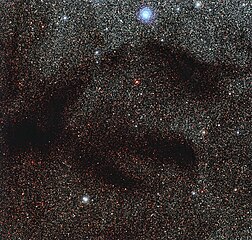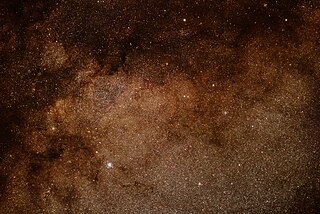Galaxies

A galaxy is a collection of stars, stellar remains, interstellar gas, dust, and dark matter that are gravitationally bonded together. A galaxy range in size from dwarf galaxies with fewer than 100 million stars to supergiants, which have 100 trillion stars around their galaxy's center of mass. It's believed that the centers of several of them contain supermassive black holes. The majority of galaxies are between 3,000 and 300,000 light years apart and are spaced at intervals of millions of light years.
Galaxies can be classed as spiral, elliptical, or irregular based on certain characteristics. They can also be further split based on the predominant morphology of their visible stars. These various geometries are believed to be the result of various rates and types of star formation, as well as later dynamical influences from dark matter distributions.
Galaxies are made up of many different elements, such as stars, gas, and dust, as well as an opacity that is typically attributed to dark matter. Particular importance is attached to a galaxy's star component.
Blazar

A relativistic jet, which is a jet made up of ionized matter moving at almost the speed of light, is directed very nearly at an observer and is characteristic of an active galactic nucleus (AGN) called a blazar. Blazars appear significantly brighter than they would if the jet were pointing away from Earth because of relativistic beaming of electromagnetic radiation from the jet. It has been established that blazars are generators of high-energy gamma ray photons and are potent sources of emission across the electromagnetic spectrum. Blazars are extremely variable sources that frequently experience abrupt and dramatic changes in brightness over short periods of time (hours to days). Another result of material in the jet moving toward the observer at almost the speed of light is the apparent superluminal motion that some blazar jets appear to be experiencing.
Elliptical galaxies
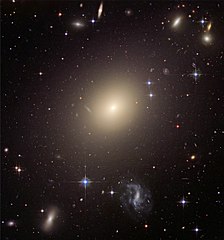
A form of galaxy known as an elliptical galaxy has a smooth, nearly featureless appearance and an approximate ellipsoidal shape. The majority of elliptical galaxies are made up of older, low-mass stars, have a scant interstellar medium, little star formation, and are frequently ringed by numerous globular clusters. Elliptical galaxies range in size from dwarf ellipticals with tens of millions of stars to supergiants with more than one hundred trillion stars that are the dominant members of their galaxy clusters..
Distant galaxies
It is challenging to determine the sort of galaxy distant galaxies are due to their tremendous distance. It has also taken time for the light to reach us so the observed galaxy was probably very early in its development. Another aspect is that we have so little data to go on with that other than say it is some kind of early galaxy we can’t be sure what type it is.
Dwarf galaxies

A dwarf galaxy is a relatively tiny galaxy with between 1000 and several billion stars. Some people believe the Large Magellanic Cloud, which closely orbits the Milky Way and has about 30 billion stars, to be a dwarf galaxy, while others see it as a full-fledged galaxy. It is believed that interactions with larger galaxies have a significant impact on the development and activity of dwarf galaxies. Based on their structure and makeup, astronomers classify dwarf galaxies into a variety of categories.
Interacting galaxies
Galaxies that perturb one another because to their gravitational fields are known as colliding or interacting galaxies. A satellite galaxy disrupting the spiral arms of the main galaxy is an illustration of a minor interaction. A galactic collision, which could result in a galaxy merger, is an example of a massive collision. During galactic evolution, galaxies frequently collide. These are gravitational interactions rather than collisions in the conventional sense due to the exceedingly tenuous distribution of matter in galaxies.
Irregular galaxies
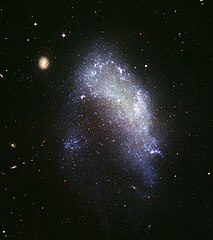
In contrast to spiral or elliptical galaxies, irregular galaxies lack a recognizable regular shape. In addition to not fitting into any of the normal classes, irregular galaxies frequently have a chaotic appearance and lack either a nuclear bulge or any indication of spiral arm structure. They are estimated to make up around 25% of all galaxies in total. Some asymmetric galaxies that are now irregular were formerly spiral or elliptical galaxies that were distorted by an unequal external gravitational influence. Typically, irregular galaxies are tiny, with a mass of only a tenth that of the Milky Way galaxy. They are vulnerable to environmental influences like colliding with massive galaxies and cosmic radiation because of their small sizes.
Lenticular galaxies
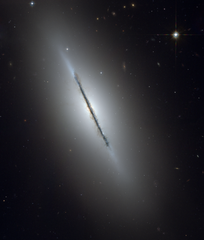
A form of galaxy that lies somewhere between an elliptical and a spiral galaxy is called a lenticular galaxy. It lacks large-scale spiral arms but has a large-scale disc. Lenticular galaxies are disc galaxies with very little continuing star formation because they have mostly used up or lost all of their interstellar materials. However, they might keep a lot of dust in their disks. They are primarily made up of elderly stars as a result (like elliptical galaxies). Lenticular and elliptical galaxies share characteristics including spectral features and scale relations despite their physical variances. Both types of galaxies, at least in the region where they are located, can be regarded as early-type galaxies that are passively evolving.
Quasar

A supermassive black hole with a mass between millions and tens of billions of solar masses that is fueled by a superluminous active galactic nucleus (AGN) and encircled by a gaseous accretion disc is known as a quasar, also known as a quasi-stellar object. Due to friction, the gas in the disc that is falling towards the black hole heats up and emits electromagnetic radiation as a result. The most potent quasars have luminosities hundreds of times larger than that of a galaxy like the Milky Way, demonstrating the immense radiant energy of quasars. Typically, quasars are classified as a subclass of the AGN category, which is more broadly defined.
Peculiar galaxy

A strange galaxy is one that has distinctive dimensions, features, or composition. Five to ten percent of known galaxies fall into the unusual category. Interacting galaxies and active galactic nuclei are the two categories of strange galaxies that astronomers have discovered. When two galaxies are relatively close to one another, their gravitational pulls can cause them to take on wildly erratic shapes. Since the bulk of peculiar galaxies credit their formation to such gravitational forces, the terms "interacting galaxy" and "peculiar galaxy" have come to be synonymous.
Radio galaxies

A radio galaxy is a galaxy having enormous radio emission areas that extend well beyond the visible structure of the galaxy. Its active galactic nucleus's jets fuel these powerful radio lobes. The synchrotron process is responsible for the radio emission. The interaction of twin jets with the external medium, which is then altered by the effects of relativistic beaming, produces the observable structure in radio emission. Large elliptical galaxies make up the majority of the host galaxies. The ability to identify radio-loud active galaxies at great distances makes them useful tools for observational cosmology. The impacts of these objects on the intergalactic medium have recently received a lot of attention, especially in galaxy groups and clusters.
Ring galaxies

A galaxy that resembles a circle is known as a ring galaxy. Numerous big, relatively young blue stars that are exceptionally brilliant can be found in the ring. There isn't a lot of bright substance in the center. Some astronomers think that smaller galaxies pass through the center of larger galaxies to create ring galaxies. This "collision" hardly ever causes any actual star collisions because the majority of a galaxy is empty space. However, due to the gravitational perturbations brought on by such an occurrence, the larger galaxy can experience a wave of star creation. Other astronomers believe that when external accretion occurs, rings are created around some galaxies. The shocks and compressions of the accreted material would then induce star formation.
Seyfert galaxy

Along with quasars, Seyfert galaxies make up one of the two major groupings of active galaxies. They contain quasar-like nuclei (very bright, far-off sources of electromagnetic radiation) with very high surface brightnesses, and their spectra show strong, high-ionization emission lines. However, unlike quasars, their host galaxies are easily discernible.
Seyfert galaxies, which make up 10% of all galaxies but are closer and less brilliant than quasars, are among the most closely researched objects in astronomy because they are assumed to be driven by the same processes as quasars. These galaxies include supermassive black holes at their centers that are encircled by accretion discs of material falling into the galaxy. The UV radiation seen is thought to have originated from the accretion discs. The greatest indicators for the makeup of the surrounding material are ultraviolet emission and absorption lines.
Most Seyfert galaxies appear to be regular spiral galaxies when viewed in visible light, but when examined at other wavelengths, it is evident that their core luminosities are on par with that of entire galaxies the size of the Milky Way. Carl Seyfert, who initially identified this class in 1943, is honored by the term Seyfert galaxies.
Multiple Galaxies
Galaxy cluster

A galaxy cluster, also known as a cluster of galaxies, is a structure made up of several hundred to thousands of galaxies that are gravitationally connected together. These galaxies typically have masses between 1014 and 1015 solar masses. The intracluster medium is a crucial component of clusters (ICM). The ICM is made up of hot gas between the galaxies that is influenced by the cluster's overall mass. Galaxy clusters should not be confused with globular clusters, which commonly circle galaxies, or with galactic clusters, also known as open clusters, which are star clusters within galaxies. Galaxy groups, as opposed to galaxy clusters, are used to describe small collections of galaxies. Superclusters can form when galaxy groupings and clusters combine together. The Virgo Cluster, Fornax Cluster, Hercules Cluster, and Coma Cluster are notable galaxy clusters in the very nearby Universe. Gigantic enough to have an impact on the local expansion of the Universe is the Great Attractor, a massive collection of galaxies dominated by the Norma Cluster.
Galaxy group

A galaxy group, also known as a group of galaxies, is a collection of galaxies with at least 50 gravitationally bound members that are each at least as bright as the Milky Way. Galaxy clusters are collections of galaxies that are larger than groupings. Superclusters of galaxies can be formed by grouping together groups and clusters of galaxies. The Milky Way galaxy is a member of the Local Group of galaxies.
Supercluster

Superclusters are among the biggest known structures in the cosmos; they are a vast collection of smaller galaxy clusters or galaxy groups. The Milky Way is a member of the Local Group galaxy group, which is made up of over 54 other galaxies. The Local Group galaxy group is a member of the Virgo Supercluster, which is a member of the Laniakea Supercluster. Superclusters, in contrast to clusters, grow with the Hubble expansion due to their huge size and low density. There are thought to be 10 million superclusters in the observable universe.


